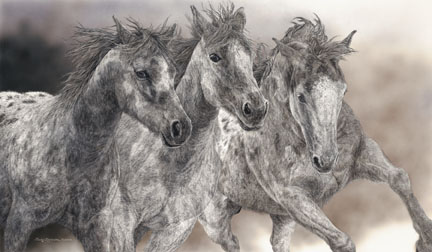

Described in 1806 by explorer Meriwether Lewis as "lofty, elegantly formed, active and durable; in short, many of them look like fine English coursers," the spotted horses of the Nez Perce Indian tribe were unlike any he and William Clark had ever seen. Named by the Nez Perce after the Palouse River, these wildly colored horses were believed to be gifts from the gods.
In 1877, the Nez Perce entered into a war with the U.S. Government, and the entire tribe, with its several thousand carefully bred horses, embarked upon a journey that would take them 1,300 miles toward Canada and safe haven. Only forty miles from the border, the Nez Perce were besieged and outnumbered by the U.S. Cavalry. Forced to surrender, Chief Joseph and his captured people were taken far from their homeland. Their exceptional horses, which Chief Joseph referred to as "my children," were deliberately killed by the soldiers. Only a few horses were lost in the mountains, sold in the East, or hidden away by ranchers. By the beginning of the twentieth century, fewer than 300 of the magnificent Appaloosa horses remained.
"The Protesters" portrays three prized Nez Perce horses, running for their lives, in an attempt to evade the three U.S. Cavalry soldiers (hidden in their coats) bent on their destruction. These horses represent the spirit of the Nez Perce, which continues to survive and endure against all odds.
| Edition Type | Edition Size | Edition Dim. | Edition Price | |
|---|---|---|---|---|
| Fine Art Print | 1000 | 28"w x 16 ½"h | $245 |